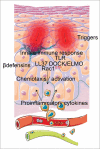Epidermal activation of the small GTPase Rac1 in psoriasis pathogenesis
- PMID: 28055293
- PMCID: PMC6548294
- DOI: 10.1080/21541248.2016.1273861
Epidermal activation of the small GTPase Rac1 in psoriasis pathogenesis
Abstract
The small GTPase Ras-related C3 botulinum toxin substrate 1 (RAC1) plays a central role in skin homeostasis, including barrier function, wound healing and inflammatory responses. Psoriasis is a common skin disease characterized by deregulation of these functions, and affected skin exhibit keratinocyte hyperproliferation, inflammation and immune cell infiltration. Although psoriasis is often triggered by environmental stimulus, there is a strong genetic association with genes expressed in both immune cells and keratinocytes, of which several are linked to Rac1 signaling. Rac1 is highly active in human psoriatic lesional skin and keratinocytes, and keratinocyte-specific overexpression of an activated mutant of Rac1, Rac1V12, in a transgenic mouse model closely mimics the presentation of human psoriasis. Both Rac1 activation in keratinocytes and immune derived stimulus are required to drive psoriasiform signaling in transgenic mouse and human xenograft models of psoriasis. Therefore, understanding how increased Rac1 activation in psoriatic epidermis is regulated is central to understanding how the abnormal crosstalk between keratinocytes and immune cells is maintained.
Keywords: Rac1; crosstalk; epidermis-immune; keratinocyte; psoriasis.
Figures

Similar articles
-
RAC1 activation drives pathologic interactions between the epidermis and immune cells.J Clin Invest. 2016 Jul 1;126(7):2661-77. doi: 10.1172/JCI85738. Epub 2016 Jun 13. J Clin Invest. 2016. PMID: 27294528 Free PMC article.
-
RAC1 in keratinocytes regulates crosstalk to immune cells by Arp2/3-dependent control of STAT1.J Cell Sci. 2012 Nov 15;125(Pt 22):5379-90. doi: 10.1242/jcs.107011. Epub 2012 Sep 6. J Cell Sci. 2012. PMID: 22956547
-
A role for mitogen-activated protein kinase activation by integrins in the pathogenesis of psoriasis.J Clin Invest. 2001 Aug;108(4):527-36. doi: 10.1172/JCI12153. J Clin Invest. 2001. PMID: 11518726 Free PMC article.
-
Psoriasis: the epidermal component.Clin Dermatol. 2007 Nov-Dec;25(6):589-95. doi: 10.1016/j.clindermatol.2007.09.021. Clin Dermatol. 2007. PMID: 18021897 Review.
-
Resident skin cells in psoriasis: a special look at the pathogenetic functions of keratinocytes.Clin Dermatol. 2007 Nov-Dec;25(6):581-8. doi: 10.1016/j.clindermatol.2007.08.013. Clin Dermatol. 2007. PMID: 18021896 Review.
Cited by
-
RAC1 Involves in the Radioresistance by Mediating Epithelial-Mesenchymal Transition in Lung Cancer.Front Oncol. 2020 Apr 28;10:649. doi: 10.3389/fonc.2020.00649. eCollection 2020. Front Oncol. 2020. PMID: 32411607 Free PMC article.
-
New Frontiers in Psoriatic Disease Research, Part I: Genetics, Environmental Triggers, Immunology, Pathophysiology, and Precision Medicine.J Invest Dermatol. 2021 Sep;141(9):2112-2122.e3. doi: 10.1016/j.jid.2021.02.764. Epub 2021 Jul 22. J Invest Dermatol. 2021. PMID: 34303522 Free PMC article. Review.
-
Significance of host antimicrobial peptides in the pathogenesis and treatment of acne vulgaris.Front Immunol. 2024 Dec 18;15:1502242. doi: 10.3389/fimmu.2024.1502242. eCollection 2024. Front Immunol. 2024. PMID: 39744637 Free PMC article. Review.
-
Skin Cancers and the Contribution of Rho GTPase Signaling Networks to Their Progression.Cancers (Basel). 2021 Aug 28;13(17):4362. doi: 10.3390/cancers13174362. Cancers (Basel). 2021. PMID: 34503171 Free PMC article. Review.
-
Rho-GTPase pathways may differentiate treatment response to TNF-alpha and IL-17A inhibitors in psoriatic arthritis.Sci Rep. 2020 Dec 10;10(1):21703. doi: 10.1038/s41598-020-78866-2. Sci Rep. 2020. PMID: 33303908 Free PMC article.
References
-
- Das T, Safferling K, Rausch S, Grabe N, Boehm H, Spatz JP. A molecular mechanotransduction pathway regulates collective migration of epithelial cells. Nat Cell Biol 2015; 17(3):276-87; PMID:25706233; http://dx.doi.org/10.1038/ncb3115 - DOI - PubMed
-
- Benitah SA, Frye M, Glogauer M, Watt FM. Stem cell depletion through epidermal deletion of Rac1. Science 2005; 309(5736):933-5; PMID:16081735; http://dx.doi.org/10.1126/science.1113579 - DOI - PubMed
-
- DiPersio CM. Double duty for Rac1 in epidermal wound healing. Sci STKE 2007; 2007(391):pe33; PMID:17579242; http://dx.doi.org/10.1126/stke.3912007pe33 - DOI - PubMed
-
- Russell AJ, Fincher EF, Millman L, Smith R, Vela V, Waterman EA, Dey CN, Guide S, Weaver VM, Marinkovich MP. Alpha 6 beta 4 integrin regulates keratinocyte chemotaxis through differential GTPase activation and antagonism of alpha 3 beta 1 integrin. J Cell Sci 2003; 116(Pt 17):3543-56; PMID:12865436; http://dx.doi.org/10.1242/jcs.00663 - DOI - PubMed
-
- Keestra AM, Winter MG, Auburger JJ, Frässle SP, Xavier MN, Winter SE, Kim A, Poon V, Ravesloot MM, Waldenmaier JF, et al.. Manipulation of small Rho GTPases is a pathogen-induced process detected by NOD1. Nature 2013; 496(7444):233-7; PMID:23542589; http://dx.doi.org/10.1038/nature12025 - DOI - PMC - PubMed
Publication types
MeSH terms
Substances
LinkOut - more resources
Full Text Sources
Other Literature Sources
Medical
Research Materials
Miscellaneous
